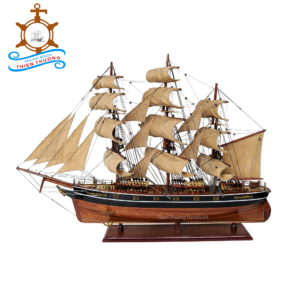Product Description
SORLANDET
SORLANDET
| Dimensions | 104L x 30W x 89H (cm) |
|---|

The Santa María was built in Pontevedra, Galicia, in Spain's north-west region. The Santa María was probably a medium-sized nau (carrack), about 58 ft (17.7 m) long on deck, and according to Juan Escalante de Mendoza in 1575, the Santa Maria was “very little larger than 100 toneladas” (about 100 tons, or tuns) burthen, or burden, and was used as the flagship for the expedition. The Santa María had a single deck and three masts.
The other ships of the Columbus expedition were the biggercaravel-type ships Santa Clara, remembered as La Niña (“The Girl”), and La Pinta (“The Painted”). All these ships were second-hand (if not third- or more) and were not intended for exploration. The Niña, Pinta, and the Santa María were modest-sized merchant vessels comparable in size to a modern cruising yacht. The exact measurements of length and width of the three ships have not survived, but good estimates of their burden capacity can be judged from contemporary anecdotes written down by one or more of Columbus' crew members, and contemporary Spanish and Portuguese shipwrecks from the late 15th and early 16th centuries which are comparable in size to that of the Santa Maria. These include the ballast piles and keel lengths of the Molasses Reef Wreck and Highborn Cay Wreck in the Bahamas. Both were caravel vessels 19 m (62 ft) in length overall, 12.6 m (41 ft) keel length and 5 to 5.7 m (16 to 19 ft) in width, and rated between 100 and 150 tons burden. The Santa María, being Columbus' largest ship, was only about this size, and the Niña and Pinta were smaller, at only 50 to 75 tons burden and perhaps 15 to 18 meters (50 to 60 feet) on deck (updated dimensional estimates are discussed below in the section entitled Replicas).

Sorry, this item is no longer available for sale. If you initiate a reproduction request, we need a min order of 10-20 units/item.

In 1869 John Willis, a shipowner and ship's captain from London, commissioned the building of the clipper CUTTY SARK in order to beat the THERMOPYLAE (built one year before) in the “tea race”. The name CUTTY SARK is of Scottish origin and means “short shirt”. The figurehead is a witch called Nannie.
Under 1877 the full-rig ship sailed almost exclusively as a tea dipper on the China route and she frequently achieved speeds of up to 17 knots. Then from 1877 onwards the CUTTY SARK served mainly in the Australian wool trade

Reviews
There are no reviews yet.